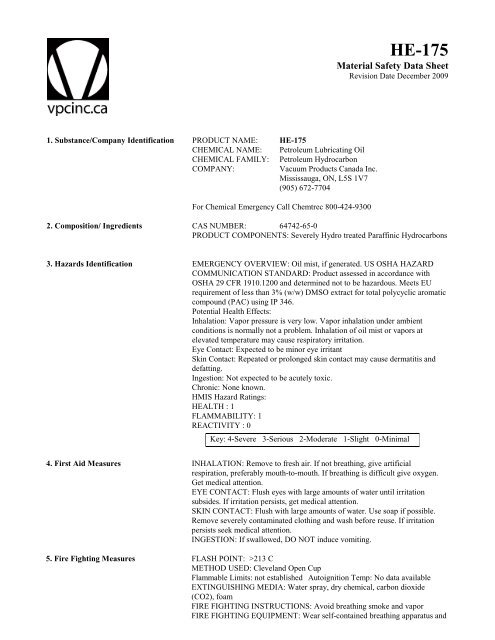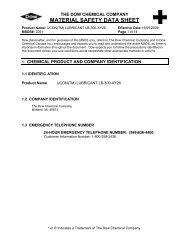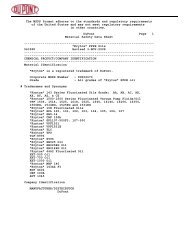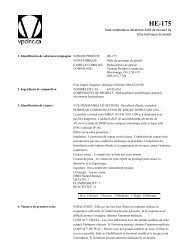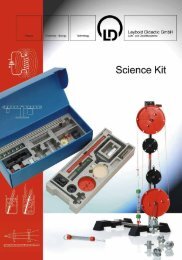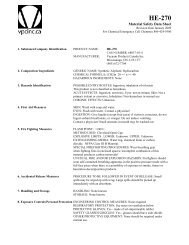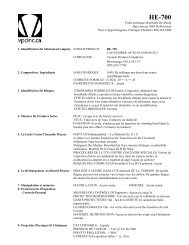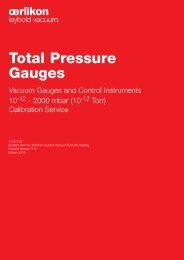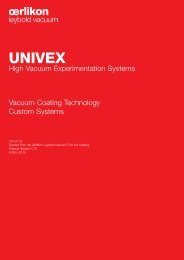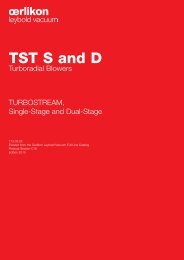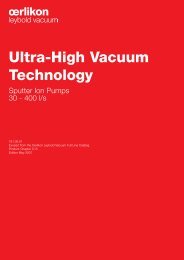HE-175 - Vacuum Products Canada Inc.
HE-175 - Vacuum Products Canada Inc.
HE-175 - Vacuum Products Canada Inc.
You also want an ePaper? Increase the reach of your titles
YUMPU automatically turns print PDFs into web optimized ePapers that Google loves.
<strong>HE</strong>-<strong>175</strong><br />
Material Safety Data Sheet<br />
Revision Date December 2009<br />
1. Substance/Company Identification PRODUCT NAME: <strong>HE</strong>-<strong>175</strong><br />
C<strong>HE</strong>MICAL NAME: Petroleum Lubricating Oil<br />
C<strong>HE</strong>MICAL FAMILY: Petroleum Hydrocarbon<br />
COMPANY:<br />
<strong>Vacuum</strong> <strong>Products</strong> <strong>Canada</strong> <strong>Inc</strong>.<br />
Mississauga, ON, L5S 1V7<br />
(905) 672-7704<br />
For Chemical Emergency Call Chemtrec 800-424-9300<br />
2. Composition/ Ingredients CAS NUMBER: 64742-65-0<br />
PRODUCT COMPONENTS: Severely Hydro treated Paraffinic Hydrocarbons<br />
3. Hazards Identification EMERGENCY OVERVIEW: Oil mist, if generated. US OSHA HAZARD<br />
COMMUNICATION STANDARD: Product assessed in accordance with<br />
OSHA 29 CFR 1910.1200 and determined not to be hazardous. Meets EU<br />
requirement of less than 3% (w/w) DMSO extract for total polycyclic aromatic<br />
compound (PAC) using IP 346.<br />
Potential Health Effects:<br />
Inhalation: Vapor pressure is very low. Vapor inhalation under ambient<br />
conditions is normally not a problem. Inhalation of oil mist or vapors at<br />
elevated temperature may cause respiratory irritation.<br />
Eye Contact: Expected to be minor eye irritant<br />
Skin Contact: Repeated or prolonged skin contact may cause dermatitis and<br />
defatting.<br />
Ingestion: Not expected to be acutely toxic.<br />
Chronic: None known.<br />
HMIS Hazard Ratings:<br />
<strong>HE</strong>ALTH : 1<br />
FLAMMABILITY: 1<br />
REACTIVITY : 0<br />
Key: 4-Severe 3-Serious 2-Moderate 1-Slight 0-Minimal<br />
4. First Aid Measures INHALATION: Remove to fresh air. If not breathing, give artificial<br />
respiration, preferably mouth-to-mouth. If breathing is difficult give oxygen.<br />
Get medical attention.<br />
EYE CONTACT: Flush eyes with large amounts of water until irritation<br />
subsides. If irritation persists, get medical attention.<br />
SKIN CONTACT: Flush with large amounts of water. Use soap if possible.<br />
Remove severely contaminated clothing and wash before reuse. If irritation<br />
persists seek medical attention.<br />
INGESTION: If swallowed, DO NOT induce vomiting.<br />
5. Fire Fighting Measures FLASH POINT: >213 C<br />
METHOD USED: Cleveland Open Cup<br />
Flammable Limits: not established Autoignition Temp: No data available<br />
EXTINGUISHING MEDIA: Water spray, dry chemical, carbon dioxide<br />
(CO2), foam<br />
FIRE FIGHTING INSTRUCTIONS: Avoid breathing smoke and vapor<br />
FIRE FIGHTING EQUIPMENT: Wear self-contained breathing apparatus and
<strong>HE</strong>-<strong>175</strong> Page 2<br />
protective clothing. Use water spray to keep fire-exposed containers cool.<br />
HAZARDOUS COMBUSTION PRODUCTS: Normal combustion forms<br />
carbondioxide and water vapor; incomplete combustion can produce carbon<br />
monoxide.<br />
6. Accidental Release Measures PROCEDURE TO BE FOLLOWED IN EVENT OF RELEASE: Remove<br />
sources of ignition. Contain any spills with dikes or absorbents to prevent<br />
migration and entry into sewers or streams. Take up small spills with absorbent<br />
pads. Large spills may be taken up with pump or vacuum.<br />
7. Handling and Storage GENERAL: Keep container closed. Store in a cool, well ventilated place.<br />
Keep away from heat, sparks and flame. Empty containers may contain<br />
residues.<br />
STORAGE TEMPERATURE: Ambient<br />
STORAGE PRESSURE: Atmospheric<br />
8. Exposure Controls/Personal Protection EXPOSURE LIMITS: Oil mist if generated: TLV (ACGIH) 5mg/m3-8hr<br />
TWA, STEL (ACGIH) 10mg/m3, PEL (OSHA) 5 mg/m3-8hr TWA<br />
VENTILATION: Good ventilation at source of vapor<br />
PERSONAL PROTECTION: For open systems where contact is likely, wear<br />
safety glasses with side shields, long sleeves and chemical resistant gloves.<br />
9. Physical & Chemical Properties PHYSICAL STATE: Liquid<br />
VAPOR PRESSURE: < .0001 Torr @ 25C<br />
BOILING POINT: 112 C<br />
EVAPORATION RATE (n-Bu Acetate = 1): Nil<br />
VAPOR DENSITY: approximately 14<br />
VOC: NA<br />
SPECIFIC GRAVITY: 0.87<br />
VISCOSITY: 55 cst @ 40 C<br />
SOLUBILITY IN WATER: Nil<br />
APPEARANCE: Pale yellow viscous liquid with a faint<br />
petroleum odor.<br />
10. Stability & Reactivity STABILITY: Stable under normal temperatures and pressures<br />
CONDITIONS TO AVOID: None known<br />
INCOMPATIBILITY (MATERIALS TO AVOID): Strong oxidizing agents<br />
HAZARDOUS POLYMERIZATION: Will not occur<br />
HAZARDOUS DECOMPOSITION: None<br />
11. Toxicological Information Oral Toxicity (rats): Practically non-toxic (LD50: greater than 2000 mg/kg)<br />
Dermal Toxicity (rabbits): Practically non-toxic (LD50: greater than 2000<br />
mg/kg)<br />
Inhalation Toxicity (rats): Practically non-toxic (LC50: greater than 5 mg/l)<br />
Eye Irritation (rabbits): Practically non-irritating. (Draize score: greater than 6<br />
but 15 or less)<br />
Skin Irritation (rabbits): Practically non-irritating. (Primary Irritation Index: ><br />
than 0.5 but less than 3)<br />
Chronic Toxicology: Product not classified as a carcinogen. It contains less<br />
than .3% w/w DMSO extract as measured by IP-346.<br />
Ecotoxicity: No data available<br />
Environmental Fate: This material is not expected to present any<br />
environmental problems other than those associated with oil spills.<br />
12. Ecological Information This product is not regulated by CERCLA/RCRA as a hazardous waste or<br />
material. Therefore, it may be disposed of as an industrial waste in a manner<br />
acceptable to good waste management practice and in compliance with<br />
applicable local, state and federal regulations.
<strong>HE</strong>-<strong>175</strong><br />
Page3<br />
13. Disposal Considerations Product and packaging must be disposed of in accordance with Federal,<br />
State and local regulations.<br />
14. Transport Classification DOT:<br />
Description Proper Shipping Name: Not regulated<br />
Hazard class: Not regulated<br />
ID Number: Not Regulated<br />
Packing Group: Not regulated<br />
Special Information: Not Applicable.<br />
IMO:<br />
Proper Shipping Name: Not regulated<br />
Hazard Class: Not regulated<br />
Packing Group: Not Applicable<br />
Special Information: Not applicable<br />
IMO Label: Not applicable<br />
Shipping Containers: Not applicable<br />
15. Regulatory Information TSCA: This material is in compliance with the TOXIC SUBSTANCE<br />
CONTROL ACT (15 USC 2601-2629) and is listed in the TSCA Inventory.<br />
HAZARD CATEGORIES FOR SARA 311/312 REPORTING<br />
<strong>HE</strong>ALTH Immediate (Acute) No<br />
<strong>HE</strong>ALTH Delayed (Chronic) No<br />
PHYSICAL Fire No<br />
PHYSICAL Sudden release of pressure No<br />
PHYSICAL Reactive No<br />
PHYSICAL Nuisance Mist/ Dust Only No<br />
01=SARA 313 11=NJRTK 21=TSCA Sect 5(a)(2)<br />
02=MASS RTK 12=CERCLA 302.4 22=TSCA Sect 6<br />
03=NTP Carcinogen 13=MN RTK 23=TSCA Sect 12(b)<br />
04=CA Prop 65-Carcin 14=ACGIM TWA 24=TSCA Sect 8(a)<br />
05=CAProp65-ReproTox 15=ACGIH STEL 25=TSCA Sect 8(d)<br />
06=IARC Group 1 16=ACGIH Calc TLV 26=TSCA Sect 4(a)<br />
07=IARC Group 2A 17=OSHA PEL 27=Canadian WHMIS<br />
08=IARC Group 2B 18=DOT Marine Pollutant 28=OSHA CEILING<br />
09=SARA 302/304 20=EPA Carcinogen<br />
10=PA RTK<br />
The following components of this material are found on the regulatory lists<br />
indicated.<br />
DISTILLATES, HYDROTREATED <strong>HE</strong>AVY PARAFFINIC<br />
Is found on lists: 14,15,17<br />
NEW JERSEY RTK CLASSIFICATION:<br />
Under the New Jersey Right-to-Know Act L. 1983 Chapter 315 N.J.S.A.<br />
34:5A-1 et.seq., the product is to be identified as follows:<br />
PETROLEUM OIL<br />
16. Other Information The information on this form is furnished solely for the purpose of compliance<br />
with the OSHA Act, and shall not be used for any other purpose. The<br />
information herein is given in good faith and is based on data considered<br />
accurate. However, no warranty, expressed or implied, is made regarding the<br />
accuracy of these data or the results to be obtained from the use thereof.


